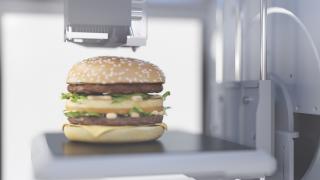
Additive manufacturing and 3D printing has been making waves throughout the manufacturing industry in recent years. From consumer products through to safety-critical industries such as aerospace, medical and marine, the growing AM storm has swept across all manner of vertical markets and revolutionised the manufacturing landscape. 3D printing has been used to create both prototype and production parts made in a variety of materials, but did you know that it’s also being used to create food products?
3D Printing and the Food Industry:
Far from just being used to produce parts for food processing machines, additive manufacturing is now being used to create food products themselves.
Far from just being used to produce parts for food processing machines, additive manufacturing is now being used to create food products themselves. A handful of 3D printer manufacturers now offer printers which are designed exclusively for use with food products, changing what is possible within the creation of culinary designs.
Food 3D printing works in the same way as printing plastic and metal components. The printer builds the product layer by layer until the full design is achieved, resulting in intricate, complex shapes which would not be possible to manufacture via other means.
READ: 3D Printing Helps To Separate Conjoined Twins
Which Foods Can Be 3D Printed?
3D printing has mostly been limited to the production of confectionery, as the likes of melted chocolate and candy make great base materials.
The foods that can be 3D printed are limited, as they must be able to be extruded via the nozzle in the printer. This reduces the scope of what is currently possible in the realm of food 3D printing, as the base ingredients must be pureed in order to be accommodated by the printer.
This means that food 3D printing has mostly been limited to the production of confectionery, as the likes of melted chocolate and candy make great base materials. However, pastry chefs have created complex cakes using 3D printers - either by using a batter filament, or simply 3D printing a mould to achieve the desired form. Dough is also easily extruded, meaning that pizza bases, cookies and biscuits have also been 3D printed for consumption. Savoury dishes have been made using meat pastes and cheeses, whilst pasta also makes a great candidate for 3D printing.
READ: Additive Manufacturing and the Medical Industry
What Are The Advantages?
Astronauts at the International Space Station 3D printed meat for the very first time in October 2019.
The main advantage to 3D printing food is that it opens new doors in terms of product design. Whilst traditional cooking and baking methods are limited when it comes to creating intricate structures, 3D printing can achieve these with ease. This makes the prospect of 3D printed food especially exciting to chefs and confectionery manufacturers who want to create an eye-catching and unusual product.
3D printing also allows for consistency from product to product, with minimal input outside of the CAD design and setup. It’s also being explored within the context of space travel, with astronauts at the International Space Station 3D printing meat for the very first time in October 2019. Indeed, this technology could go on to vastly improve the culinary options available while in orbit, as well as other space missions that we undertake in the future.
READ: Is Rapid Prototyping the Future of Manufacturing?
What Are The Disadvantages?
Regular cleaning of the printer and its components are critical, which could prove to be too time-consuming for technology that already yields a very slow output.
3D printed food may not be for everyone and there are certainly a lot of disadvantages to producing food products in this manner. Firstly, product options are limited to extrusion viability, making this technology widely inaccessible to the greater market. Secondly, 3D printing is a slow process, meaning that it may not be able to keep up with demand in environments such as restaurants and factories in its current form.
There is also the very prominent matter of food safety and making sure that 3D printed food products are fit for human consumption. This means that 3D printers must be food-safe and properly maintained. Regular cleaning of the printer and its components are critical, which could prove to be too time-consuming for technology that already yields a very slow output.
Is 3D Printing the Future of the Food Industry?
Food 3D printing will certainly be an exciting niche to observe over the coming years, although major improvements will be required before we start to see this technology in widespread commercial applications. The speed of the printing process means that food 3D printing is likely to be limited to hobbyists and smaller companies for the foreseeable future, but as additive manufacturing continues to evolve as a whole, we’re likely to see more and more 3D printed food products on our shelves.
In short, you may not be ordering a 3D printed three-course meal in 2020, but perhaps in 2030 you might be able to - if you’re not too squeamish of course!
